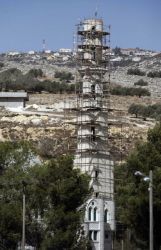On slow news days, photojournalists often go out and shoot photos of different things that catch their eye.
It gives them a chance to see things that would otherwise be overlooked while on other assignments, work a little more creatively, and — importantly — it helps build up and update a news service's bank of file photos.
File photos help papers illustrate certain stories or updates that don't lend themselves to a "breaking photo." They also give editors the option to update readers with a simple photo and caption explaining what's new.
So, for example, quality images of the Singapore skyline, a speeding truck, a German car exhibition, or even a folder may not be in high demand when the photographer goes out, but they can be useful months or years later.
But what happens when the photo has a particular agenda? That's the question I'm asking after seeing this:
Over looked by the Har Bracha Jewish settlement, a mineret is under consruction in the Palestinian village of Burin in the Israeli occupied West Bank, several kilometers from the northern city of Nablus on October 4, 2010, which the Jewish settlers are trying to block. The International Court of Justice and the international community consider the settlements being buildt in the West Bank to be illegal. (AFP/Jaafar Ashtiyeh)
The imagery consists of a Palestinian town's minaret overshadowed by an ominous Israeli settlement lurking above. The minaret is a symbol of Islam, the scaffolding a sign that not all is well. Har Bracha is close enough to be identifiably Israeli and modern, but far enough away to suggest something monolithic and faceless.
The image, in and of itself, isn't newsworthy. It's merely a vehicle for a caption reinforcing the view that settlements are illegal. And now, the image joins AFP's collection of file photos . . .


